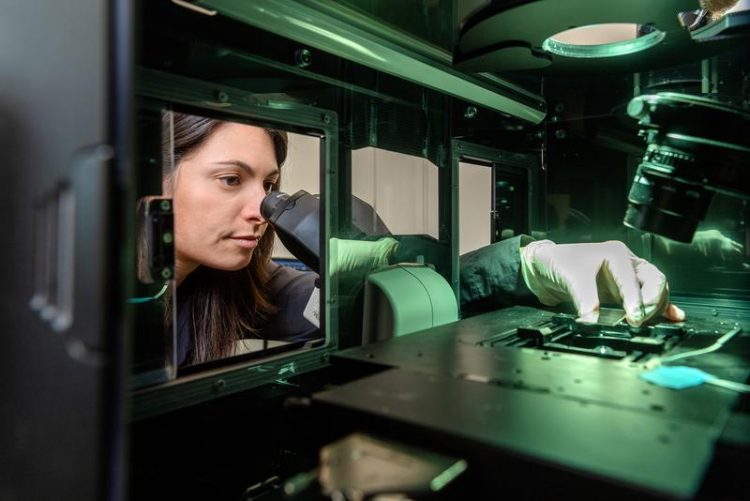For bacteria, the neighbors co-determine which cell dies first: The physiology of survival

Co-author Elena Biselli at the microscope. Bild: A. Heddergott / TUM
The survival and growth of cells are central factors in biological systems. Scientists such as Ulrich Gerland, Professor for Physics of Complex Biosystems at the TUM, are therefore trying to understand how the molecular components interact to maintain the viability of a group of cells in stress situations.
The team led by Ulrich Gerland has now succeeded in identifying two crucial factors for the survival of a bacterium: the basic energy consumption of a cell and the quantity of energy that the surviving cells can gain per neighboring dead cell, measuring the biomass recycling efficiency.
Nutrients from neighboring cell cadavers
The researchers emulated an emergency situation in cells of the bacterium Escherichia Coli in which the bacteria were lacking sugar and other carbohydrates. The bacteria therefore had neither energy nor building materials available.
As the first cells died, the surviving cells tried to gain nutrients from the surrounding cell cadavers. The higher the energy turnover of a certain enzyme, the greater was the rate of mortality. The more they were able to recycle from dead cells, the higher was the rate of survival.
“Our findings make it possible to quantitatively determine the contributions of individual molecular components to the survival of bacterial cells, for the first time,” says Gerland.
Decay of viability as a collective phenomenon
Overall, there was an exponential decrease of surviving cells with time. In principle, such a development can be explained with the random perishing of individual cells, just like in radioactive decay which also has an exponential kinetics.
But the interrelationships are more complex, as the researchers found out when they changed experimental conditions. Decay in bacterial colonies is a collective phenomenon. The surrounding bacterial cells therefore co-determine whether a cell in their midst perishes or survives.
Mathematical analysis of survival
Changes to the mortality rate can arise from a wealth of genetic or ecological perturbations which influence the survival of bacteria. The balance which emerges is therefore different for each bacterium and each environmental condition.
In order to understand the dynamics, the researchers modelled the overall system of surviving bacteria mathematically. Then, they used this relationship to determine molecular contributions to the survival of cells.
Depending on the cell type, important molecular factors for the survival of cells can be identified, and this facilitates the discovery of enzymes or other proteins that determine the rate of survival.
“Our aim is to understand, systematically and quantitatively, how bacteria manage to survive in so many environmental conditions,” says Gerland. “It is the search for the physiology of survival.”
More information:
The research was supported by the Deutsche Forschungsgemeinschaft (DFG) within the cluster of excellence Nanosystems Initiative Munich (NIM) and the priority program SPP1617, as well as by the fellowship program of the postgraduate school for Quantitative Biological Sciences Munich (QBM).
Prof. Dr. Ulrich Gerland
Physics of Complex Biosystems
Technical University of Munich
James-Franck-Str. 1, 85748 Garching
Tel.: +49 89 289 12380 – E-Mail: gerland@tum.de
Web: http://www.qbio.ph.tum.de/en/home/
Death rate of E. coli during starvation is set by maintenance cost and biomass recycling
Severin J. Schink, Elena Biselli, Constantin Ammar, Ulrich Gerland
Cell Systems, July 17, 2019 – DOI: 10.1016/j.cels.2019.06.003
https://www.cell.com/cell-systems/fulltext/S2405-4712(19)30198-X
Media Contact
More Information:
http://www.tum.deAll latest news from the category: Life Sciences and Chemistry
Articles and reports from the Life Sciences and chemistry area deal with applied and basic research into modern biology, chemistry and human medicine.
Valuable information can be found on a range of life sciences fields including bacteriology, biochemistry, bionics, bioinformatics, biophysics, biotechnology, genetics, geobotany, human biology, marine biology, microbiology, molecular biology, cellular biology, zoology, bioinorganic chemistry, microchemistry and environmental chemistry.
Newest articles

Silicon Carbide Innovation Alliance to drive industrial-scale semiconductor work
Known for its ability to withstand extreme environments and high voltages, silicon carbide (SiC) is a semiconducting material made up of silicon and carbon atoms arranged into crystals that is…

New SPECT/CT technique shows impressive biomarker identification
…offers increased access for prostate cancer patients. A novel SPECT/CT acquisition method can accurately detect radiopharmaceutical biodistribution in a convenient manner for prostate cancer patients, opening the door for more…

How 3D printers can give robots a soft touch
Soft skin coverings and touch sensors have emerged as a promising feature for robots that are both safer and more intuitive for human interaction, but they are expensive and difficult…





















